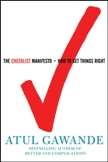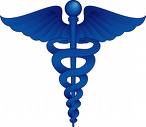To the usual list of new year's resolutions, most of them having to do with bettering ourselves in one way or another -- eating less, exercising more, learning Spanish, reading Proust -- I invite you to consider adding a new one: let's quit making so many mistakes.

That is the exhortation at the heart of Atul Gawande's new book, The Checklist Manifesto. Gawande, who is several successful careers ahead of the rest of us (he is a surgeon, a Harvard professor, and a New Yorker staff writer, not to mention a National Book Award finalist and a MacArthur winner) is accustomed to thinking about error. His first book, Complications, took a long, thoughtful look at the consequences of playing god while being human. His second, Better, tried to parse the subtle differences that enable some doctors to deliver outstanding care, while others -- including many who seem just as dedicated -- never rise above the average.
Thematically, then, The Checklist Manifesto is a logical follow-up to Gawande's first two books. It, too, concerns the maddening difficulty and unquestionable urgency of making medicine fairer, kinder, and -- especially -- safer. In other ways, though, it represents a marked departure. You can glimpse the difference just by looking at the covers. Complications is subtitled "A Surgeon's Notes on an Imperfect Science." Better is "A Surgeon's Notes on Performance." The subtitle of the new book? "How to Get Things Right." Caveat emptor: somewhere between books two and three, meditation has given way to manual.
The Checklist Manifesto is shorter and more focused than its predecessors, and, unlike them, it has an argument to make: doctors still get too much too wrong too often; many of those errors are avoidable; and the best way to avoid them is through the consistent use of carefully devised checklists. To Gawande's credit, for much of his book this argument feels as irrefutable as gravity, and nearly as important. Annually, medical errors disable at least 7 million people and kill 1 million worldwide -- the equivalent of six sold-out 747s crashing every day, killing everyone on board. Even if you grant, as Gawande does, that "sick people ...are phenomenally more various than airplanes," medicine's safety record is still shockingly bad.

Gawande argues that checklists could dramatically improve that record, and he backs his claim with the kind of stories that make his books thrilling (if occasionally eww!-inducing) to read. For instance, the procedure for safely inserting central-line catheters consists of five simple steps, which "have been known and taught for years." Yet virtually all hospitals are plagued by infections and deaths caused by improperly inserted central lines. When the state of Michigan began using a checklist for central lines in its intensive care units, its infection rate plummeted 66% in just three months. Soon, its ICUs were outperforming 90% of all hospitals nationwide. In 18 months, the checklist saved an estimated 175 million dollars and 1500 lives.
These statistics are impressive. But, as Gawande notes, inserting a central line is a particularly checklist-friendly procedure, since it involves a small number of identifiable, easy-to-monitor steps. Most of medicine is far messier. A single patient can suffer from multiple health problems requiring multiple procedures and multiple providers -- to say nothing of all the other medical wildcards, from malfunctioning equipment to the enduring mysteries of the human body.
Yet even under conditions of extreme complexity, Gawande shows, checklists still work. As head of a World Health Organization committee tasked with improving global surgical care, he helped design a checklist with a ridiculously broad mandate: to reduce errors during any kind of surgery at any hospital anywhere in the world. For three months, his team tested the list in eight pilot hospitals, from a first-class facility in Seattle to a dirt-poor clinic in Tanzania. At first, Gawande worried "about how meager the intervention was when you got right down to it. We'd provided no new equipment, staff, or clinical resources to hospitals." All he and his team could offer was "a stupid little checklist."
But that stupid little checklist worked. Major surgical complications in all eight hospitals fell 36%. Infection and deaths rates dropped by half. Equally important, the healthcare providers involved came to believe in the power of the checklist. Many had started out suspecting that it was just another bureaucratic distraction from the real business of caring for patients. Three months later, 78% of participants said they'd personally seen the checklist prevent an error in the operating room. Eighty percent said it improved patient care. And over 90% said what I as a reader had decided by this point, too: if I ever wind up on an operating table, please -- use the damn list.
***
When it comes to writing about his own profession, Gawande is the best in the game. His capacity to make us simultaneously feel the intensity of being a doctor and think about the field of medicine yielded two books that were consistently smart, humble, arresting, illuminating, and inspiring. The same goes for those chapters of The Checklist Manifesto that describe his own and his colleagues' encounters with medical error. But Gawande has something to sell in this new book, and the hustler's hat fits him awkwardly -- especially when he ventures beyond the hospital to construction companies, restaurants, and investment banks. 
This awkwardness reveals itself in both stylistic and conceptual lapses. Normally, one of the pleasures of reading Gawande is that his prose is unassuming and translucent; he is a master craftsman, but he has the restraint to get out of the way and let his subject shine through. (What you remember from his books are stories, not sentences.) Here, though, his normally companionable voice occasionally gives way to a tone both overly insistent and overly cute. The first time he trots out a dramatic pause ("There is such a strategy" -- paragraph break -- "It is a checklist"), it more or less works. But then it keeps happening. ("It's time to try something" -- paragraph break -- "Try a checklist.") At one point, he walks into a conference room and finds it adorned with "printouts of what were, to my surprise, checklists." This ersatz astonishment is followed by an ersatz eureka moment: looking around a restaurant, Gawande realizes that "there seemed no field or profession where checklists might not help. And that might even include my own."
For readers -- at least, for this one -- all this gee-whiz wonderment falls flat. Since the entire book is about checklists, we expect to find them wherever Gawande leads us; and since he is a doctor writing about medicine, we expect them to prove useful in his field. More to the point, it's not news to us that checklists are handy and popular. Junior-high kids use them to remember homework assignments, just as the rest of us use them to make sure we pick up cat food on the way home from work.
What is new and interesting in this book, then, isn't the ubiquity and utility of checklists. It's how reluctant doctors are to embrace them. One checklist, for instance, starts by instructing the members of a surgical team to introduce themselves. There is solid psychological research supporting this step, Gawande explains -- people who know each other's names function far more effectively as a team -- but, he admits, "it felt kind of hokey to me." In other words, one of medicine's most reflective and empathetic thinkers winced at being asked to do something that is not only part of best practices, but also part of barebones civility.
That was my eureka moment. In "normal" medical culture, a team is assembled to remove my pancreas and the surgeon doesn't even know the anesthesiologist's name? Pardon me, but that is friggin' astonishing. And therein lies the real lesson of this book. For all its breathtaking accomplishments, for all its legions of hardworking practitioners, medicine is so far behind when it comes to error prevention that it needs to begin with habits most of us learned in kindergarten.

To that end, checklists are a start -- but only a start. When the airline industry got serious about improving safety, it didn't just draft a bunch of lists. It also established strict protocols for everything from labeling runways to communicating with air-traffic controllers. It encouraged employees to report errors and protected them from punishment if they did so. It conducted detailed post-mortems on mistakes that did occur, in order to avert them in the future. In short, it got safer by overhauling its entire culture. Jettisoning what Gawande refers to as The Right Stuff model (individual, iconoclastic, hero-oriented), it forged an environment in which openness and transparency are prioritized, people are empowered to speak their minds and expected to listen, and power is distributed widely rather than concentrated in the hands of the few. These are democratic values, and -- as countless examples attest -- the best way to curtail error is to create a democratic society, whether it is as large as a nation or as small as a neighborhood clinic.
Gawande gets this. He argues, correctly, that for safety innovations to succeed, the masses (nurses, anesthesiology residents, medical students) must be allowed to question the authority of surgeons. And he understands that the reverse is true, too: doctors must stop dismissing crucial safety measures as "nursing stuff -- boring stuff." In the penultimate chapter, he even acknowledges that checklists are really just a means to an end. "Just ticking boxes is not the ultimate goal here," he writes. "Embracing a culture of teamwork and discipline is." In that sense, the function of the checklist is as much psychological as practical. It is a first step toward learning to live with our fallibility -- a kind of gateway drug to humility.
***
The cultural shift Gawande proposes is so important -- and thus far so elusive -- that I can see why he would champion anything that might help bring it about. But in promoting the checklist as the chief engine of that shift, he overlooks its serious limitations.
One of these is that checklists are only as reliable as their users. In my own forthcoming book on being wrong, I recount the story of a surgeon who operated on the wrong side of a patient. This mistake didn't happen because the surgeon had never heard about checklists; his hospital had a perfectly good one. But for whatever reason, on this particular occasion, he and his team failed to use it. That might seem egregious, but it is also a reality check about checklists. All of us have arrived at the grocery store only to realize that we left the shopping list at home -- which is to say, checklists inevitably interact with our humanness, including our human forgetfulness and laziness and distraction and optimism and hopeless overcommittedness.

A second limitation of checklists is that you can't put everything on them. As Gawande points out, overly long lists simply won't get used; to keep them short, many items are deemed either too routine or too rare to merit inclusion. What he fails to point out is that these omissions can have grave consequences. The most obvious one is that the routine stuff and the rare stuff are often precisely what bites you in the butt. You turn the stove off every time you use it, so why bother checking today? The stock market has always regulated itself just fine, so why start worrying in 2007?
There is also a subtler problem with leaving items off your checklist. This is the phenomenon known as inattentional blindness: when you ask people to look for something specific, they develop a startling inability to see things in general -- even things that would normally be glaringly obvious. In one rather amazing experiment, subjects are shown a video of a fast-paced ballgame and asked to count how many times the ball is passed back and forth. Partway through the video, a gorilla (actually, a person in a gorilla costume) wanders into the middle of the screen, beats its chest a few times, and then wanders off again. Here's the amazing part: between 33 and 50% of subjects don't see this happen. Perhaps this bears repeating: up to half the people instructed to pay close attention to one aspect of a video fail to notice a six-foot-tall, chest-pounding gorilla in the middle of it.
The implications for checklists are obvious. Put some items on your list, and those you leave off will become much harder to detect. Here's a thought experiment: suppose you have a hundred surgical teams perform an identical simulated surgery. Suppose you give half those teams a checklist. Now suppose the simulated surgery includes a complication that isn't on the list. Which half is going to do better at noticing the problem? I'd bet ten pounds of homemade toffee it's the group without the checklist.
This doesn't mean checklists are a bad idea. It just means they are an idea with real weaknesses, ones that need to be recognized and offset in any effective error-prevention system. That recognition is largely missing from The Checklist Manifesto. This became obvious during Gawande's discussion of the use of checklists in restaurants. I'll buy that a recipe is a kind of checklist. But when a daily meeting to address issues that have cropped up in the kitchen gets called "a communications checklist," I balk. Talking over stuff that isn't on your checklist is not a checklist. On the contrary, it is a counterbalance on your checklist -- a way to prevent inattentional blindness, and an acknowledgment that we need more than one strategy to ward off error.
I suspect Gawande understands all this. In my reading of him, he's not a one-size-fits all, cure-all kind of guy. His single-minded enthusiasm for checklists strikes me as a reflection not of his own weaknesses but those of his field. With its lagging safety standards, medicine urgently needs checklists -- which means that checklists urgently need a champion.
Gawande is the right man for the job. If you put his three books together, you get a kind of macro-narrative: the bildungsroman of a young doctor who goes from struggling for competence to striving for excellence to telling other people how to get it right. We need experts to do just that, and Gawande has recently emerged as one of the sanest voices in the debate over healthcare reform. Perhaps it's inevitable that, in assuming the mantle of policy maven, he's left behind the more nuanced, essayistic voice that put him on the map. As a reader, I hope to hear that voice again. But as a citizen, I hope even more that his colleagues heed his call, and that the humble checklist heralds a sea change in medicine as we know it.